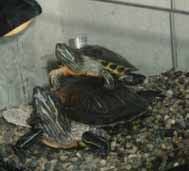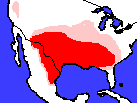Želvy nádherné jsou nejspíše nejčastěji chované želvy vůbec. Přirozeně
se vyskytují ve vodním systému Mississippi, na jihu a ve středu USA od nejzápadnějších států po Skalisté hory
a v severovýchodním Mexiku. V současnosti jsou rozšířeny po všech zemích světa, kde se jim daří
uprchnout chovatelům.
 
| Red-eared sliders are probably the most commonly kept reptile
in the world. Their home range lies in the Mississippi Valley drainage,
in New Mexico, Texas, Louisiana, Mississippi, Alabama, through Oklahoma,
Arkansas, Kansas, Kentucky, Tennessee, eastern Kansas, and Missouri north
to Indiana and Illinois. They also occur naturally in isolated pockets
in other states such as Ohio, and are common in regions of northeast Mexico
adjacent to Texas. Now they occur as well as in any country in the world
where they have been allowed to escape from keepers.
| Rozkolísané je názvosloví jak latinské (Pseudemys,
Trachemys, Chrysemys, občas i Graptemys), tak české, kde se jako obvykle spousta
autorů pracujících se slovenskými texty ani nenamáhá zjišťovat, jestli náhodou
slovenský název není jiný, než český (želva nádherná, ozdobná, pestrá atd.).
Spory o latinský název trochu přibližuje tento článek.
Chtěl jsem jej přeložit do češtiny, ale když jsem se zamyslel nad výrazy slider,
cooter a painted turtle, zjistil jsem, že to k ničemu nebude a nechal jsem jej v originálu.
| Most of misinterpretations in the names of the group Trachemys came from
the older mess in their classification. I use the system from Pritchard's Encyclopedia of Turtles which
I take as the most serious source that I have. Maybe the newer works prefer the name Trachemys for
this turtle which I accept but do not prefer. Some recent works in our language use the oldest name Chrysemys
too. Here is a copy of an article for the names given on this turtles.
| Želvy nádherné jsou typické tím, že mají červený proužek po stranách
hlavy, občas i červenou skvrnu nahoře na hlavě. Proužek je někdy rozdělen na dvě či
tři části, jeho odstín je od oranžové po rudou. U některých jedinců proužek úplně chybí.
Karapax a kůže mladých želv jsou atraktivně zbarveny od jasně po temně zelenou, s výraznou
kresbou. Dospělí jedinci jasné barvy ztrácejí - mívají olivové až hnědé zbarvení s různými barevnými
odchylkami, kresbu kůže si však uchovávají. Dospělí samci bývají melanističtí, drápy na jejich předních tlapách
jsou občas značně delší, než u samic (obrázek nahoře). Želva nádherná je v přírodě promíšena se želvami
jako želva ozdobná, se kterými se často kříží (to činívá i v zajetí), což může poněkud ztížit jejich
identifikaci. Želvy nádherné jsou první želvy, u kterých byly chovateli vyšlechtěny barevné odrůdy
(albíni, pastelové barvy aj.)
| Red-eared sliders typically have a red streak on each side of the head, and
sometimes a red spot on top of the head. The red streak is sometimes broken up into 2 or 3 spots, and varies
in shade from orange to deep red. Some sliders don't have any red streak, unfortunately. The typical hatchling has an
attractive bright green carapace and skin with well developed yellow-green to dark green pattern. Adults have shell
color changes - green to olive or brown with various color eventualities. Matured males used to
be melanistic and sometimes claws on their forelimbs become much longer than the females' (picture
above). Red-ear sliders intergrade with turtles such as the yellow-bellied slider in the wild,
and they often interbreed with other sliders in captivity, which may cause identification
problems. "Red-eared sliders have the distinction of probably being the first turtle
species to have color variants (such as albino and the pretty pastel phase) developed by breeders."

| | Mladé želvy jsou prakticky výhradně masožravé, v dospělosti se jejich
chutě poněkud mění a stávají se všežravými, často s převažující rostlinnou složkou potravy
(vodní rostliny, salát). Upřednostňují stojatou vodu s bahnitým dnem. V zajetí je vhodné
chovat je ve velkém akvateráriu (pro pár alespoň 100 x 45 x 45 cm) s poměrně velkou souší.
Ještě vhodnější je venkovní bazének zhruba 1,5 x 1,5 x 1,5 m s přilehlou ohrazenou souší.
| Young turtles are strongly carnivorous, in adulthood their apetites change a little
and they become omnivorous, often with prevailing vegetable part of nourishment (water
plants, lattuce). They prefer quiet water with a muddy bottom. In captivity it is recommended
to keep them in larger aquaterarium (for a couple at least 3 x 1.5 x 1.5 ft) with
a relatively large dry land. Much more suitable is a garden pond 5 x 5 x 5 ft with adjacent
fenced land.
| Maximální délka krunýře dosahuje cca 30 cm, průměrně ale bývá okolo 23 cm.
Počet nakladených vajec se pohybuje od 5 po 23, typicky 10. Není třeba zazimovat, na druhou
stranu želvy chované celoročně venku bez problémů v našich podmínkách přezimují.
| Maximum lenght of carapace recorded is about one feet, average is about 9 inches. Eggs
amount vary from 5 to 23, typical is 10. There's no need to hibernate them, on the other
hand turtles kept in a large pond hibernate on a muddy bottom in our climate without problems. | | | | |



